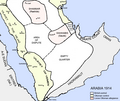Portal:Saudi Arabia
The Saudi Arabia Portal – بوابة المملكة العربية السعودية
Saudi Arabia, officially the Kingdom of Saudi Arabia (KSA), is a country in West Asia and the Middle East. It covers the bulk of the Arabian Peninsula and has a land area of about 2150000 km2 (830000 sq mi), making it the fifth-largest country in Asia and the largest in the Middle East. It is bordered by the Red Sea to the west; Jordan, Iraq, and Kuwait to the north; the Persian Gulf, Qatar and the United Arab Emirates to the east; Oman to the southeast; and Yemen to the south. Bahrain is an island country off its east coast. The Gulf of Aqaba in the northwest separates Saudi Arabia from Egypt and Israel. Saudi Arabia is the only country with a coastline along both the Red Sea and the Persian Gulf, and most of its terrain consists of arid desert, lowland, steppe, and mountains. The capital and largest city is Riyadh; the kingdom also hosts Islam's two holiest cities of Mecca and Medina. (Full article...) Selected article -Qatif or Al-Qatif (Arabic: ٱلْقَطِيف Al-Qaṭīf) is a governorate and urban area located in Eastern Province, Saudi Arabia. It extends from Ras Tanura and Jubail in the north to Dammam in the south, and from the Persian Gulf in the east to King Fahd International Airport in the west. This region has its own municipality and includes the Qatif downtown, Safwa, Saihat, Tarout Island, and many other smaller cities and towns. Qatif is one of the oldest settlements in Eastern Arabia; its history goes back to 3500 BC, more than 5000 years ago, and was part of the Bahrain Region which was called Dilmun at that time and the Sumerians knew it as the land of paradise, immortality, and life. Before the discovery of oil, Qatifi people used to work as merchants, farmers, and fishermen. However, with the development of the oil fields in the late 1940s, Qatif lost its status as an important port to Dammam, and since the 1990s has focused on the oil industry, public services, education, and healthcare sectors. (Full article...)Did you know (auto-generated)
News
Related portalsReligions in Saudi Arabia Arab states WikiProjectsThings you can do
This is a Good article, an article that meets a core set of high editorial standards.
Faisal bin Abdulaziz Al Saud (Arabic: فيصل بن عبدالعزيز آل سعود Fayṣal ibn ʿAbd al ʿAzīz Āl Suʿūd, Najdi Arabic pronunciation: [fæjsˤɑl ben ˈʕæbd ælʕæˈziːz ʔæːl sæˈʕuːd]; 14 April 1906 – 25 March 1975) was a Saudi Arabian statesman and diplomat who was King of Saudi Arabia from 2 November 1964 until his assassination in 1975. Prior to his ascension, he served as Crown Prince of Saudi Arabia from 9 November 1953 to 2 November 1964, and he was briefly regent to his half-brother King Saud in 1964. He was prime minister from 1954 to 1960 and from 1962 to 1975. Faisal was the third son of King Abdulaziz, the founder of modern Saudi Arabia. Faisal was the son of Abdulaziz and Tarfa bint Abdullah Al Sheikh. His father was still reigning as Emir of Nejd at the time of Faisal's birth, and his mother was from the Al ash-Sheikh family which has produced many prominent Saudi religious leaders. Faisal emerged as an influential royal politician during his father's reign. He served as viceroy of Hejaz from 1926 to 1932. He was the Saudi foreign minister from 1930 and prime minister from 1954 until his death, except for a two-year break in both positions from 1960 to 1962. After his father died in 1953 and his half-brother Saud became king, Faisal became crown prince, and in that position he outlawed slavery in Saudi Arabia. He persuaded King Saud to abdicate in his favour in 1964 with the help of other members of the royal family and his maternal cousin Muhammad ibn Ibrahim Al ash-Sheikh, Grand Mufti of Saudi Arabia. (Full article...)Selected pictureMore did you know
General imagesThe following are images from various Saudi Arabia-related articles on Wikipedia.
Featured contentFeatured articlesGood articles
Associated WikimediaThe following Wikimedia Foundation sister projects provide more on this subject:
Sources
Discover Wikipedia using portals | ||||







![Image 2A view of Jabal Sawda, a peak located in Saudi Arabia, with an elevation of around 3,000 metres (9,843 ft).[1]](http://upload.wikimedia.org/wikipedia/commons/thumb/5/59/Al_Sawda_peak.jpg/120px-Al_Sawda_peak.jpg)





















































